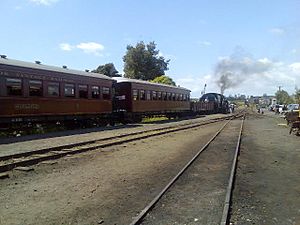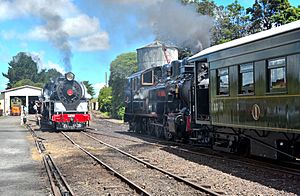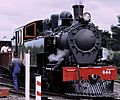Glenbrook Vintage Railway facts for kids
Quick facts for kids Glenbrook Vintage Railway |
|
|---|---|

JA1250 leads a passenger train on the Glenbrook Vintage Railway at the railway's workshops, 3 January 2008.
|
|
| Locale | Glenbrook, Auckland, |
| Commercial operations | |
| Name | Part of the Waiuku branch line |
| Built by | New Zealand Government Railways |
| Original gauge | 1,067 mm (3 ft 6 in) |
| Preserved operations | |
| Owned by | Glenbrook Vintage Railway Trust Board |
| Stations | Five |
| Length | 7.4 km |
| Preserved gauge | 1,067 mm (3 ft 6 in) |
| Commercial history | |
| Opened | 1922 |
| Closed | 1967 |
| Preservation history | |
| Reopened | 1977 |
The Glenbrook Vintage Railway (GVR) is a special steam railway in Glenbrook, New Zealand. It's a place where old trains come back to life! This railway is run by a group of dedicated volunteers. They work hard to keep these historic trains running.
The railway is about 7.4 kilometers long. It carries many passengers each year. You can ride the trains during its main season. This runs from October to June. You can also book special trips throughout the year. The GVR is a fun way to experience history. It's a great place for families and train fans.
Contents
Discover the Glenbrook Vintage Railway's History
The GVR uses part of an old railway line. This line was called the Waiuku branch line. It first opened in 1922. The line closed down in 1967. But people wanted to save it.
How the Railway Was Rebuilt
The idea for a steam railway started when the line closed. A group called the Railway Enthusiasts Society (RES) loved this route. So, they decided to rebuild it. Work began in 1970. Volunteers cleared away thick gorse. They also replaced old railway tracks. They built the Pukeoware Depot and the Glenbrook station.
Old trains and carriages were brought to Glenbrook. Some steam locomotives came all the way from the South Island. Carriages were chosen from trains that were no longer used. Some had special meaning to the RES members.
Opening and Early Journeys
In 1977, the railway officially opened. It ran between Glenbrook and Pukeoware. At first, smaller diesel engines were used. Then, steam locomotive No. 1 (WW 480) started pulling trains. It had two carriages, a guard's van, and an open car.
A big moment happened in 1985. Steam locomotives JA 1250 and KA 945 pulled a train. It went from Auckland to Wellington and back. This was the first time steam trains ran on the main line again. It was a very exciting event.
Expanding the Railway Line
The railway was extended to Fernleigh in 1986. This added 6 kilometers to the line. New Zealand's Prime Minister, David Lange, opened this extension. A special train called the "Sunset Coast Express" ran. It brought many people from Auckland.
More improvements were made in the 1980s and 1990s. Plans were made to extend the line to Waiuku. The original Waiuku station was gone. So, a new station was planned at Tamakae Reserve. A temporary station opened at Victoria Avenue. The new route opened for regular service in 2010. Old bridges were made stronger. New tracks were laid. The railway continues to plan for the final extension.
On January 7, 2007, the railway reached a milestone. It carried its one millionth passenger!
Experience the Glenbrook Vintage Railway in Action
The railway offers different ways to enjoy the trains. You can visit on standard operating days. Or you can come for special events.
Standard Operating Days: What to Expect
The railway runs on certain Sundays. It also operates on public holiday weekends. This is from Labour weekend to Queen's Birthday weekend. Steam trains leave Glenbrook every 90 minutes. The first train is at 11 am. The last is at 4 pm.
A round trip takes about 60 minutes. You'll ride from Glenbrook to Victoria Avenue. The engine then moves to the other end of the train. You'll then go to Pukeoware Workshops. Here, you can visit the workshops. Finally, the train returns to Glenbrook. When the train is away, you can also try hand jigger rides. These are small rail vehicles.
Special Operating Days: Unique Events
The GVR hosts many special events. These include Lego Weekends and Santa Days. There are also Steam Festivals and Easter Celebrations. "Day Out With Thomas" weekends are very popular. Each season has its own unique events.
Day Out With Thomas Weekends
These are the railway's most popular events. Two trains, up to six carriages long, run. They leave Glenbrook every half-hour. This is usually from 10 am to 4 pm.
A smaller "shuttle train" also runs. It links the railway to the main KiwiRail network. Sometimes, a small diesel locomotive called "Basil" pulls it. Other times, WW 480 "Terry the Tank Engine" is used. More recently, "Thomas the Tank Engine" himself visits! This "Thomas" is a special engine from the Mainline Steam Trust.
You might also see double-decker buses. There are also traction engines and vintage cars. These displays add to the fun. On "Day Out With Thomas" weekends, trains only go to Fernleigh. Then they return to Pukeoware and Glenbrook.
Railfan Days: For Train Enthusiasts
The first Railfan Day was in 1996. It celebrated the completion of a historic carriage. On these days, special trains run. You can see different passenger and freight trains. Historic trains and locomotives are often featured. Sometimes, visiting locomotives come too.
Steam Traction Festivals: A Celebration of Steam
Steam festivals bring many steam-powered vehicles together. The GVR held its first festival in 2002. This celebrated its 25th anniversary. Many visiting railway locomotives came. There were also steam boats and miniature locomotives. Even a steam-powered car was on display! Trains ran every half-hour.
A second festival was in 2007. It featured a special showman's engine. This event also celebrated the return of WW 644. It was back in service after 37 years. A third festival happened in 2009. It included a historic 19th-century tank engine. This engine pulled a demonstration freight train.
A fourth festival took place in 2013. It showed a half-scale replica of a Newcomen engine. This engine was 5.5 meters tall. It was based on engines from 300 years ago. Six locomotives pulled passenger trains. There were also displays of vintage machines. A vintage helicopter even gave rides.
Volunteer Crewing: How the Railway Runs
The GVR relies on volunteers. They make sure everything runs smoothly. There are two main teams. The Operations Branch runs the trains. The Commercial Branch handles things at Glenbrook Station.
Commercial Team Roles
This team works at Glenbrook Station. They prepare the station for visitors. They sell tickets and souvenirs. They also prepare and sell refreshments. They help with parking on busy days. They also operate hand-powered and motorized jiggers. Their main job is to help customers.
Operations Team Roles
This team operates the trains. Their roles usually need special training. Many start in the Commercial Branch. Or they begin as Assistant Guards.
- Train Controller/Signalman: This person is in charge of the railway's daily operations. They work in the signal box at Glenbrook Station. They make sure trains run safely. They also manage signals and keep trains on schedule.
- Engine Driver: The driver is on the locomotive. They manage the train's safe operation. They prepare the locomotive. They also work with the fireman. They make sure the train runs on time.
- Fireman: The fireman works with the engine driver. They help prepare the locomotive. They manage the water and fire. This keeps the steam pressure high. Firemen often train to become engine drivers.
- Cleaner: Cleaners assist the engine driver. They help with coupling and uncoupling trains. They also help prepare the locomotive. They assist the fireman with coal and water. They also help clean the locomotive after the day.
- Guard: The guard is responsible for safety on the train. They look after passengers. They manage the train's brake system. They signal when the train can move. They also manage the assistant guards.
- Assistant Guard: They help the guard. They ensure passenger safety. They assist with boarding and leaving the train. They also help with the braking system. They communicate with the guard.
- OIC (Officer in Charge) Pukeoware: This person manages operations at Pukeoware Depot. They focus on safe train movements. They work with the train controller. They also manage the Pukeoware Road level crossing.
Buildings and Facilities: Where the Magic Happens
Glenbrook House: A Place for Training
Glenbrook House was moved from Waiuku. It was restored in 1995. It's now used for training and meetings. It's also a preparation area for big events. It's located right next to the railway line.
Pukeoware Workshop: Restoring History
The railway restores trains at its workshop. This workshop is at Pukeoware. It's about four kilometers from Glenbrook. The main yard has heavy engineering workshops. Here, locomotives are repaired. There's also a car and wagon shop. This shop does carpentry and paint work. There are also sheds to store carriages.
The workshop maintains trains for the GVR. It also helps with national excursions. It has won awards for its restoration work. The workshop has also helped other railway groups. It even helped prepare carriages for a restaurant. And it was used for filming TV shows!
The Signal Box: Controlling the Tracks
Glenbrook Station has a restored signal box. It used to be in Auckland. It controlled signals in the old Auckland yards. Now, it controls all signals at Glenbrook. It also controls points for the railway. It even won an award for its restoration.
Station Buildings: Historic Homes for the Railway
The railway cares for many historic station buildings. They all came from old New Zealand Railways stations.
- Glenbrook Station's main building combines two old stations. These are the original Glenbrook and Patumahoe station buildings.
- Glenbrook Station's picnic shelter is from Kingsland suburban station. It was moved in 2003.
- Morley Road's station building is the original Pukeoware station building.
Rolling Stock: The Trains of GVR
Steam Locomotives: Powerful Giants
- JA 1250: This tender locomotive was built in 1949. It was bought by Phil Goldman in 1972. It ran the first steam excursion on the main line in 1985. It was given to the GVR in 2007. It is currently being repaired.
- No. 1 (WW 480): This tank locomotive was built in 1910. The GVR bought it in 1969. It was repaired and returned to service in 2018. It is now running again.
- No. 2 (WW 644): This tank locomotive was built in 1915. It returned to service in 2007. It is now being repaired with a new boiler.
- No. 4 (Taupo Totara Timber Co. Mallet No. 7): Built in 1912, this is the railway's most famous engine. It's New Zealand's only Mallet Compound Steam Engine. It last worked in 2001. It is sometimes displayed for special events.
- F 233: This tank locomotive was built in 1885. It was donated to the GVR in 1964. It is stored at the Pukeoware workshops. Its unique saddle tank was added by a previous owner.
Diesel Locomotives: Workhorses of the Railway
Diesel locomotives are used for various tasks. They help with shunting and maintenance.
- No. 3 (Ruston and Hornsby): This was the railway's first locomotive. It is still working today.
- No. 7 (DS 207): This is the only one left of its kind. It is currently being repaired.
- No. 8 (DE 507): This locomotive is working. It is used for passenger service and work trains.
- No. 9 (DE 509): This locomotive is not working. It is stored at Pukeoware.
- No. 10 (DSA 243): This is one of three surviving locomotives of its class. It was repaired in 2008.
- No. 11 (DBR 1254): This locomotive was bought in 2017. It can run on the main line.
- No. 12 (DBR 1295): This locomotive was also bought in 2017. It has been repainted in its original colors. It is now in service.
- No. 14 (DCP 4818): This locomotive was bought in 2018. It is being repaired to run on the main line.
Passenger Carriages: Riding in Style
The GVR has many passenger carriages. They are from the late 1800s and early 1900s. Most are narrow, wooden carriages. They are painted red. They have opening windows and outdoor viewing balconies. They are named after Māori migration canoes.
- AF 804 "Tainui": A carriage with a guards' compartment.
- A 1161 "Mataatua": A standard passenger carriage.
- A 1162 "Aotea": Another standard passenger carriage.
- A 1222 "Te Arawa": A carriage with seats along the sides.
- F 141 "Nga Tira": A former guards' van. It's now an open viewing carriage. It's also called the "Chicken Coop."
- VB 624 "Waka Whenua": A former support wagon. It's now an uncovered outdoor viewing carriage.
Some unique carriages are used for special occasions:
- C 472: A very old six-wheeled carriage from 1879. It was fully restored in 1996. It runs on special event days.
- A 543 "Manakura": A kitchen/diner carriage with stained glass windows. It's currently stored.
- A 1452: A "wide-body" carriage. It's restored as a parlor carriage. It has a bar and lounge. It's used for special charter trips.
- AF 1182: A carriage being converted into a dining car. It will have a food preparation area and a toilet.
National Network Fleet: Traveling New Zealand
The railway also has a fleet of carriages. These can travel on the main KiwiRail network. They have been all over New Zealand. They are painted in the GVR's yellow, white, and chocolate colors.
This fleet includes:
- Four carriages built in the early 1900s. They were used on express services.
- Three carriages built during World War II. They were used on Auckland commuter trains.
- Five 'small window' carriages. They are currently being repaired for main line use.
- Three 'big window' carriages. They are also stored and waiting for repairs.
The Guard's Van FM 1133 is also part of this fleet. It has a kitchen for catering on trips.
Former Auckland Transport Carriages
The Railway Enthusiasts Society bought 13 carriages in 2021. These were used in Auckland until 2014/15. They are being tested and certified. They will be stored for future use.
Freight Wagons: Moving Goods
The railway has many freight wagons. They have been bought, donated, or leased. They are used for demonstration runs. They are also used for photographers. The railway has ballast wagons and a plough van. These are used for track work. Other wagons include refrigerated wagons and cement wagons.
Images for kids







